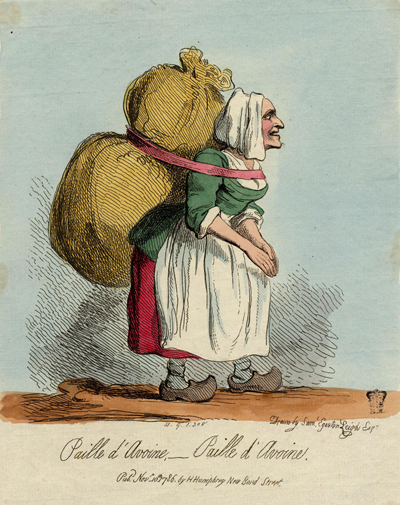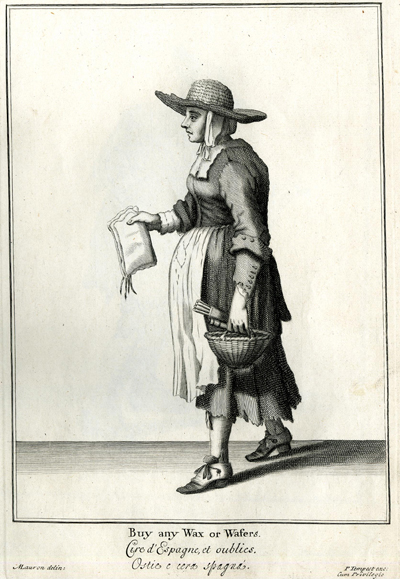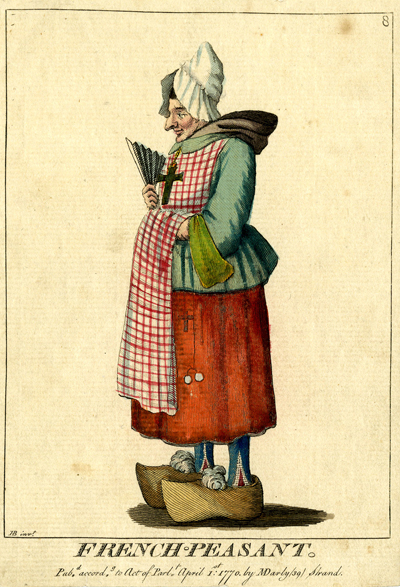Paille d'Avoine, Paille d'Avoine
Paille d'avoine is French for oat straw, which is the hay-like grass that grows with green oats. As an herb in tea, it has traditionally been used to improve brain function and ease feelings of anxiety and stress. The repetitive French title suggests that this is the sing-song cry of a street vendor: Oat Straw! Oat Straw! As the author line indicates, this rather charming print is based on a drawing by 26 year old Samuel Egerton Leigh (1760–1786), (a distant relation of Jane Austen) which Gillray simply etched and published.

© Trustees of the British Museum
The depiction of street vendors was popular in the 17th and 18th centuries in both France and England. In France, series included the extensive Cris de Paris (1737-1746) by Edme Bouchardon consisting of five sets of twelve prints each, and, in England, The Cryes of the City of London (1687) by Marcellus Laroon, which began as a 40 Plate series in the first edition, but soon expanded to 74. Laroon's Cryes were reprinted throughout the 18th and into the 19th century. Later in the century there appeared at least two more series: London Cries (1770) by Paul Sandby, and Cries of London (1793-1797) by Francis Wheatley.

Buy any Wax or Wafers: Cryes of the City of London
[1688]
© Trustees of the British Museum
But perhaps the most immediate influence upon the young artist may have been William Henry Bunbury's caricatures of foreigners, including French Peasant (1770) and Peasant of the Alps (1771).

French Peasant
[April 1, 1770]
© Trustees of the British Museum
Bunbury's work might have appealed to Leigh because like Bunbury, Leigh was an artistically inclined younger son of a baronet.
In addition to this caricature, Leigh was the author of an incredibly sentimental and highly moralistic novel, Munster Abbey, a Romance: Interspersed with Reflections on Virtue and Morality which was obviously intended to capitalize on the craze for Gothic Romance launched by Ann Radcliffe with novels like The Romance of the Forest (1791 and The Mysteries of Udolpho (1794).* Unfortunately, Leigh did not live long enough to fully enjoy the fruits of his various endeavors. He died on December 11, 1796), a month after this caricature (November 10) and the birth of his only son (November 16). His novel, supposedly finished by his wife from his papers, was published posthumously in 1797.
* Unintentionally hilarious excerpts can be found at A Course of Steady Reading
Sources and Reading
- Commentary from the British Museum on Paille d'Avoine, Paille d'Avoine.
- "Cries of London," Spitalfields Life
- "Sir Samuel Egerton Leigh," The Peerage
- "Oat Straw," Health Library: Winchster Hospital
- Thomas Wright and R.H. Evans, Historical and Descriptive Account of the Caricatures of James Gillray #372.
- Thomas Wright and Joseph Grego, The Works of James Gillray, the Caricaturist; With the History of His Life and Times p. 83.
Comments & Corrections
NOTE: Comments and/or corrections are always appreciated. To make that easier, I have included a form below that you can use. I promise never to share any of the info provided without your express permission.